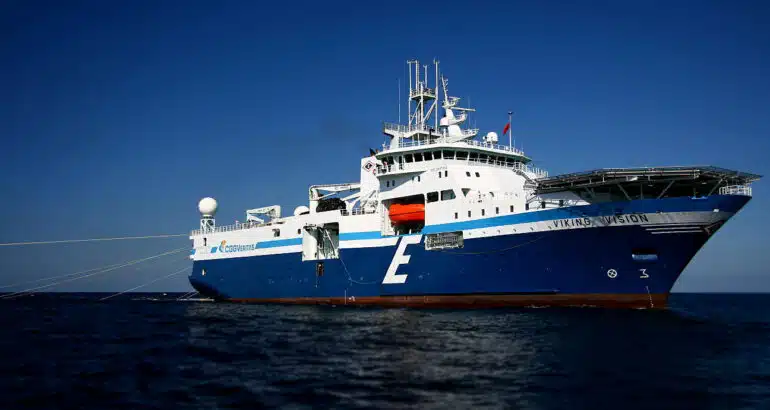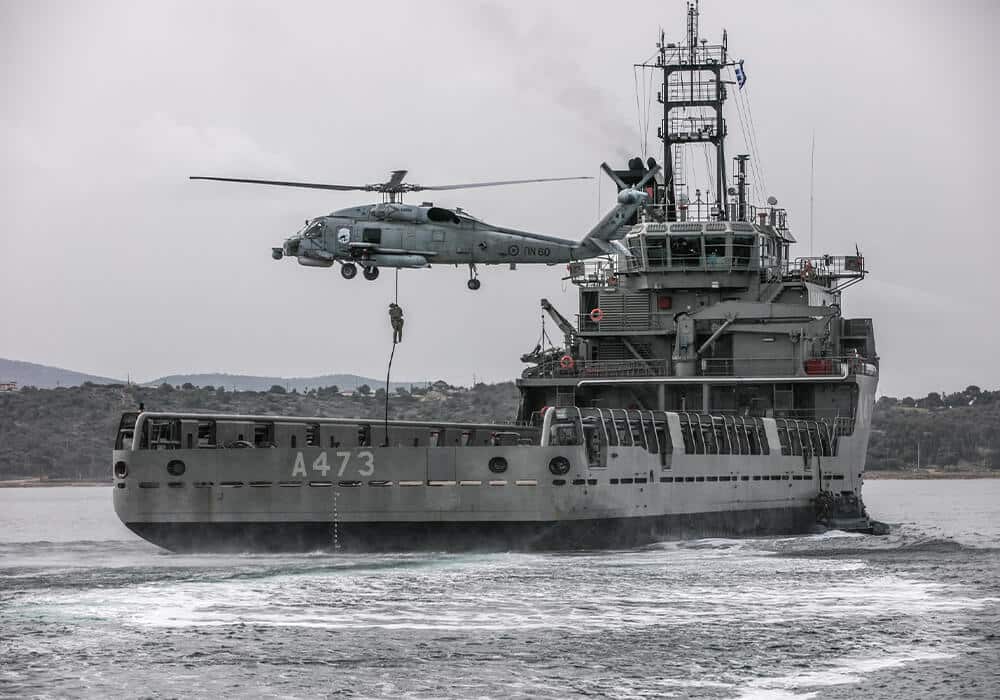Panos Laskaridis: New Multi-Purpose Ship Donated To The Hellenic Navy

Shipowner and president of Aikaterini Laskaridis Foundation Panos Laskaridis donates an 105-meter ship to the Hellenic Navy. This is the 5th ship Laskaridis donates to the Navy.
“Viking Vision” is the 5th ship Laskaridis donates to the Hellenic Navy. It will be renamed when entering service with the Navy.
The Greek shipowner and president of Aikaterini Laskaridis Foundation, Panos Laskaridis is about to donate a new large multi-purpose ship to the Hellenic Navy. The ship, is yet another kind donation of numerous donations over the last two decades by Laskaridis and his family to the Greek Navy and the Coast Guard, which include weaponry, patrol vessels, auxiliary and training ships, repairs and upgrades of older vessels and lighthouses. The close connection of Panos Laskaridis with the Hellenic Navy and his multi-faceted contribution to it, affirms in the best manner the unbreakable bond between the Hellenic Merchant Marine and the Hellenic Navy as joint guardians of Greek naval power and seamanship.

The new ship is the 5th ship that Laskaridis donates to the Navy. In December 2014 he donated the 37-meter Kyknos (A-484), a small training ship. In 2019, Laskaridis, purchased from Simon Møkster Shipping AS the platform supply vessel (PSV) Stril Neptun and donated it soon after to the Navy. The ship took the name Atlas I (A-471) on December 2, 2019 at the Salamis Naval Base. The Dutch-built PSV Atlas I, built in 1999, is 70.4m long, 16m long wide and has a full load displacement of 5,300 tons. Her maximum speed is 14kts. After the donation of Atlas I, a new donation by Laskaridis of an even newer, larger and more powerful ship followed up. The former Norwegian-built Highland Navigator of GulfMark, was named Herakles on July 6, 2020. Herakles (A-472) was built in 2002, is 84 meters long, 18.8m long wide and has a full load displacement of more than 6,900 tons. Her maximum speed is 15kts. On November 25, 2021, a third PSV joined the Hellenic Navy, the 83.3-meter PSV Wilson Atlantic of Wilson Offshore, that was named Aias (Ajax). Aias (A-473) was built in 2003, is 18.8m long wide and has a full load displacement of more than 7,500 tons. Her maximum speed is 16kts. Τhe three former PSVs serve as general support ships.

All three ships are equipped with an integrated Dynamic Positioning (DP) 2 system, the Kongsberg SDP-21. The DP system consists of a number of bow, stern and azimuth thrusters, extra generators, position reference systems and control consoles, that automatically controls a vessel’s position and heading by using her own propellers and thrusters. Thanks to this system in combination with the ship’s sensors and the rest of the equipment on board, the ships have excellent maneuverability and can execute any mission given with great accuracy. The three ships have receive a number of M2HB heavy machine guns, general purpose machine guns and Stinger MANPADS as well as communication equipment and other conversions required by the Navy.

The Swiss Army Knives of the Navy
The three vessels, from built, have a satisfactory refueling side-by side-at idle replenishment capability. Atlas I also is capable of static continuous towing (bollard pull) of 100 tons through two towing winches she incorporates. The ship also can perform as a powerful firefighting vessel thanks to its water cannons incorporated over the bridge and the rest of the equipment across the hull.
Ships like PSVs, have been designed as multi-mission support ships to replace many different types of auxiliary ships, thus achieving economy and providing a variety of options to the user. Their powerful deck crane is suitable to lift a wide range of cargo and equipment and accommodate it on the very large open deck which is designed for heavy load cargo (>2,600t on Herakles). On their open cargo decks, in military use, they accommodate and secure a wide range of cargoes of significant quantities such as spare parts, consumables and other supplies, ammunition and food for the supply of friendly ships, containers, isoboxes, surveillance systems, and even heavy armament and special transport capabilities such as Remotely Operated-underwater Vehicles (ROV) or other autonomous systems, unmanned aerial vehicles (UAV), Special Forces teams with their equipment and others. Further, they are capable to support mine warfare operations or potentially, after the appropriate modification, to execute minelaying. They can also contribute considerably in humanitarian relief efforts, search and rescue operations or handling of marine pollution incidents.

Another special capability that these ships can offer is, with the addition of necessary equipment, the ability to rescue submarines that are unable to resurface by their own efforts. Ships which are equipped with DP2 systems, can hover at the distressed submarine (DISSUB) using their thrusters, even under demanding weather conditions, carrying on their large open decks the required equipment for the task. The Hellenic Navy is pioneer in the utilization of these kind of ships and their successful career led other Navies, which visited the Greek ships, to acquire also similar vessels for their Fleets. They are low cost solutions with significant military capabilities. And the Hellenic Navy acquired them for free thanks to the donator Panos Laskaridis.
Viking Vision, the new ship for the Hellenic Navy

Built in 1993 and fully rebuilt and converted in 2007 as a research vessel in Norway (only part of the hull remained the same), the ship was operated by Eidesvik Shipping AS until 2017. Her current name is Viking Vision and will receive a new name from Greek mythology. Key features include a gross tonnage of 9,811 tons and a deadweight tonnage of about 5,052 tons, an overall length of 105m, breadth of 24m, 8.5m draught and a maximum speed over 17kt.
The ship carries two 8.1-meter VIKING Norsafe JYW 80 CA lifeboats which can carry 70 persons each. The two lifeboats are launched and recovered by two ACEBi 44150 ST Herblon davits. A 7.7-meter VIKING Norsafe Magnum 750 RHIB is launched by a TTS Marine HL9DP-A-MOB3500 FR SWL 3,5T davit. Magnum 750 can reach a maximum speed of 30 kts with three persons on board. There are also four life rafts that can carry 140 persons in total. Two Vestdavits TDB-10000-10T can launch and recover up to 10t of equipment, boats and other sensors or systems for research or military operations.

The navigation and communication equipment includes one JRC 10cm radar ARPA, one JRC 3cm radar ARPA, AIS, Electronic Chart System, Gyro Compass, DGPS, Autopilot System, Echo Sounder, Doppler log system, wind sensors, radio plants, satellite communications and other sensors. The maneuvering system is a Rolls Royce Helicon X3, the tracking System is Simrad STS 500, the planning station is JRC NWZ-158 and the Integrated Automation System (IAS) is Wärtsilä’s. The ship is characterized by electrical redundancy, which means that it is fitted with multiple systems for propulsion or electrical power and thus ensuring power production and thereby operational reliability and the ship’s safety.
The crew consists of about 18 people. The total number of sleeping cabins is 44 while there are 70 beds which can be increased to about 200 in fully air-conditioned comfortable cabins and areas. There is an elevator also that can fit a bed which is suitable for medical operations. Food supplies in large quantities can be stored in the ship in specially designed areas. Note that the ship has gyms, sauna, cinema, dining rooms, recreations rooms, hospital, conference rooms, laundry rooms and other facilities in order to support the personnel for months of operations!

A large flight deck of 22,2 meters diameter and made of high quality marine aluminum is located forward of the bridge which can accommodate a helicopter up to 12.8t. Therefore helicopters in Greek inventory such as Seahawk or Super Puma can land there with safety.
The space aft of the main deck is suitable for the accommodation of more than 20 RHIB. The stern ramp can be converted for the launch of the RHIB which can be transferred and launch very quickly thanks to electric overhead traveling cranes or winches. The large interior space of the ship provided for the storage of the already removed seismographic survey equipment can accommodate the personnel of the RHIB and their equipment.

The ship can carry up to 3,000 cubic meters of marine gas oil (MGO), 517 cubic meters of water and 2,692 cubic meters of ballast (which can be converted to increase the carried MGO). It has multiple davits for RHIB, rescue boats or other equipment, while it has three cranes on deck; two MacGregor HMC1610 LK 80-17 (10T@10m / 8T@17m) at starboard and port side and one MacGregor HMC1610 LK 55-17 aft (10T@10m / 5,5T@17m).
The new vessel is expected to arrive in Greece this summer and soon after will join the Navy. The stern ramp, the flight deck, the numerous accommodation areas, the tanks and the storage rooms will provide tremendous capabilities to the Hellenic Navy and will enable it to conduct a wide range of support roles, including the transport of cargo and fuel, emergency towing, floating hospital, minelaying, mine countermeasure operations, special operations, research, and humanitarian relief.
ΠΗΓΗ: Navalnews.com

 Ακολουθήστε το
Ακολουθήστε το